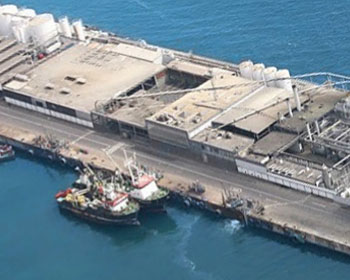|

Camanchaca plant. (Photo: Camanchaca)
Camanchaca lost USD 9 million in 2015 due to lower prices and catches
 (CHILE, 3/10/2016)
(CHILE, 3/10/2016)
A significant drop in salmon prices combined with lower fish catches, contributed for Camanchaca to close 2015 with a loss of USD 9 million, while in 2014 it had obtained a profit of USD 11.1 million.
The company informed the Salmon business had a loss of USD 6.8 million compared with a profit of USD 6.5 million last year.
And while the Fishing business recorded a profit of USD 1,400 million, this result is far below what had been reported last year, when the company earned a profit of USD 6,200 million. This was because their own catches were reduced by 52,000 tonnes in the north zone due to the impact of oceanographic conditions of El Niño, and to the 23,000 tonnes not included in the sardine quota in the south-central area.
Camanchaca noted that this result considers the extraordinary effect of the compensation insurance associated to the earthquake in April 2014 in Iquique and Calbuco volcano eruption, and the sale of noncore assets, all of which left a positive effect and margin of USD 7.8 millions.
Salmon lower price and smaller fishing catches impacted heavily on income decrease by 11.5 per cent to USD 439 million, with declines in all businesses: Fishing (-21.0 per cent), Salmon (-5,6 per cent) and Farmed products (-8.4 per cent).
EBITDA before fair value (FV) of USD 21.6 million represented a decrease of USD 44.5 million compared to 2014.
As indicated by the company, the main factors that explain the results obtained in 2015 were:
a. Lower price of salmon, which fell 20.6 per cent, or USD 1.1 per kilo WFE, compared with the price of 2014.
b. Normal sanitary conditions and decreasing costs in salmon farming centres.
The company reported that health conditions deteriorated by the end of the year because of SRS and low oxygen in certain centres. However, it stressed that the relative good condition of its centres, and better production management, coupled with cost containment initiatives, helped to reduce unit costs by 12 per cent, from USD 3.41/kg ex-cage live fish in 2014, to USD 3,01/kg in 2015.
c. Difficulty in horse mackerel, sardine and anchovy captures.
In the case of the horse mackerel, fishing began late in 2015 due to the mixing of juveniles with adults. However, during the third quarter there was a significant recovery and the entire annual quota of the company was possible to be caught in the southern-central area, with 43,000 tonnes.
In the sardine fishery, catches were 24.2 per cent lower than those in 2014 due to lower quota and the abundance of temporary closures due to undersized fish in Region VIII.
Catches of anchovy in the north were 32.8 per cent lower than in 2014, with late starts caused by high presence of undersized fish and strongly impacted by El Niño phenomenon, which made it possible to capture 2/3 of the annual quota. The total catch was 87,000 tonnes, compared with 129,000 in 2014, which turned 2015 into the worst year as to catches since 1998.
d. Lower fishmeal and fish oil sales in 2015 -- 25.7 per cent and 57.0 per cent lower compared to the previous year --, due to lower catches and slower sales of inventories in a context of declining prices in the year. The average price of fishmeal in the year was USD 1,780 per ton, not enough to offset lower sales.
[email protected]
www.seafood.media
Information of the company:
|
Address:
|
El Golf 99 - Piso 10
|
|
City:
|
Las Condes
|
|
State/ZIP:
|
Santiago de Chile
|
|
Country:
|
Chile
|
|
Phone:
|
+56 2 363 5700
|
|
Fax:
|
+56 2 426 0440
|
|
E-Mail:
|
[email protected]
|
|
Skype:
|
https://www.instagram.com/camanchaca.amiga/?h
|
More about: 
|
|
|
Approval / Accreditation / Certified / Oversight by...







|



